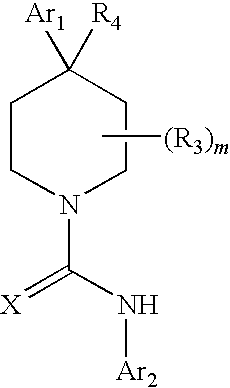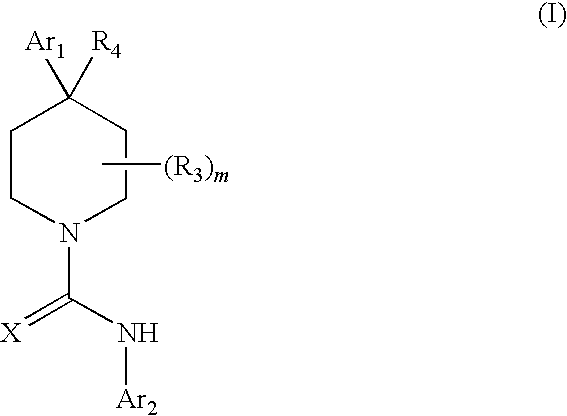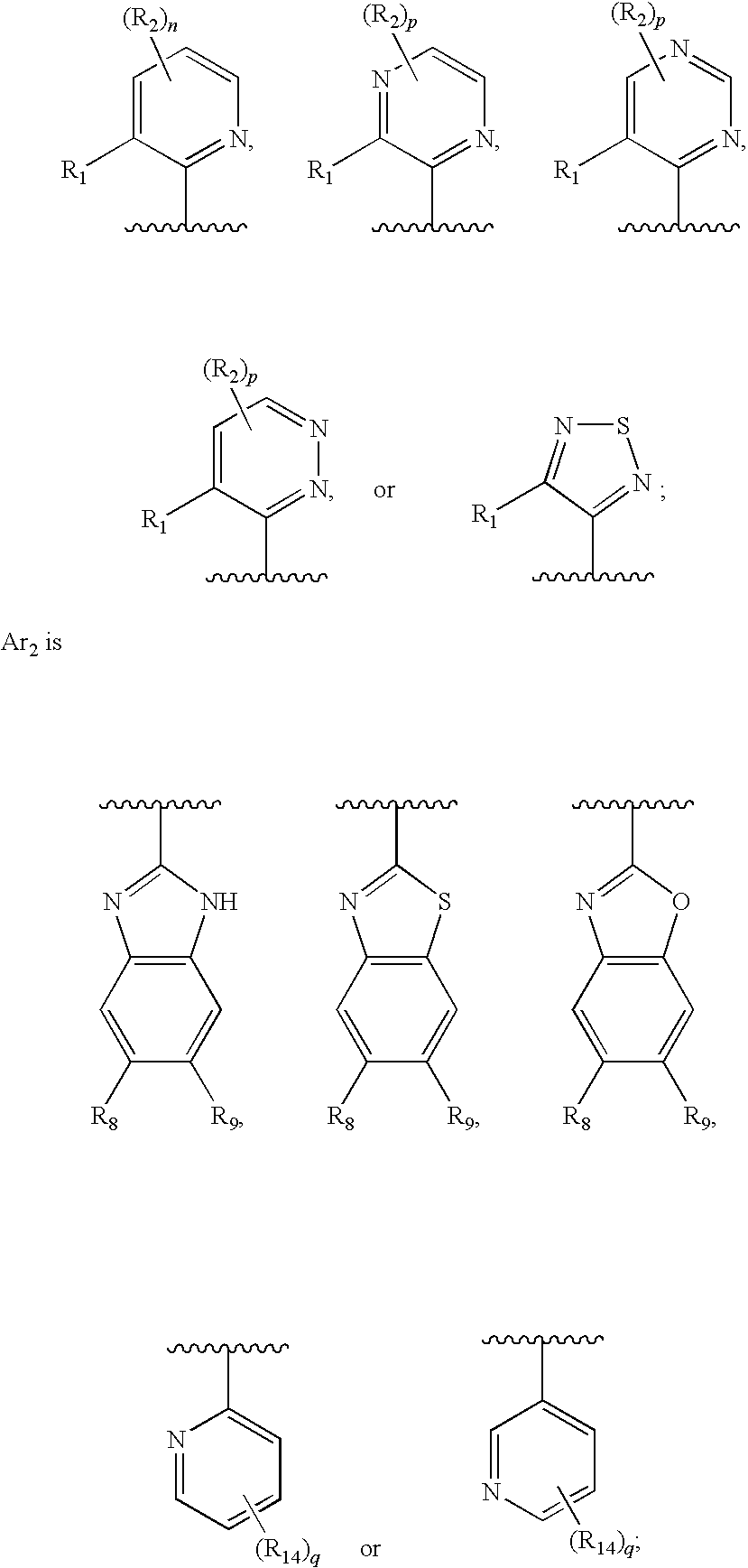Therapeutic agents useful for treating pain
a technology of therapeutic agents and compounds, applied in the field of piperidine compounds, can solve the problems of ineffective drugs, no existing commercial drug treatment for ui patients has achieved complete success in all classes of ui patients, and treatment occurred without significant adverse side effects
- Summary
- Abstract
- Description
- Claims
- Application Information
AI Technical Summary
Problems solved by technology
Method used
Image
Examples
example 1
5.1 Example 1
Synthesis of Piperidine Compounds CYE and EKG
[0875]
[0876]2-amino-6-fluorobenzothiazole (15.0 g, 89.2 mmol) was dissolved in DMF (100 mL) and cooled to about 0° C. under a nitrogen atmosphere. 1,1-Carbonyldiimidazole (15.2 g, 93.6 mmol) was added to the reaction mixture and the reaction mixture allowed to stir at about 0° C. for about 1 h. The reaction mixture was then allowed to warm to about 25° C. and stirred for about 3 h. The resulting reaction mixture was then diluted with acetone (100 mL) and filtered to provide the acyl-imidaxole A (14.5 g, 55.2 mmol) as a yellowish solid. The acyl-imidaxole A was suspended in anhydrous DMF (100 mL), 1,4-dioxa-8-aza-spiro [4,5] decane (7.9 g, 55.2 mmol) was added to the resulting suspension, and the suspension was allowed to stir for about 1 h. at about 100° C. under a nitrogen atmosphere. The solvent was then removed under reduced pressure and the resulting residue poured into a 1M aqueous sodium bicarbonate solution and allowed...
example 2
5.2 Example 2
Synthesis of Piperidine Compounds AYH and AMT
[0885]Compounds AYH and AMT were obtained by a method analogous to that used to obtain Compounds EKG and CYE as described above in Example 1 except that 4-tert-butyl aniline was used in place of 2-amino-6-fluorobenzothiazole.
example 3
5.3 Example 3
Synthesis of Piperidine Compounds EKE and CYC
[0886]Compounds EKE and CYC were obtained by methods analogous to those described above.
[0887]The Structure of Compounds EKE and CYC was confirmed by 1H NMR and mass spectrometry (MS).
[0888]Compound EKE: 1H NMR (CDCl3) δ 8.40 (dd, J=1.0, 4.7 Hz, 1H), 7.77 (d, J=2.0 Hz, 1H), 7.59 (d, J=8.6 Hz, 1H), 7.55 (dd, J=0.8, 7.6 Hz, 1H), 7.36 (dd, J=2.0, 8.6 Hz, 1H), 7.22 (dd, J=4.7, 7.6 Hz, 1H), 6.75 (br s, 1H), 4.20 (m, 2H), 3.64 (t, J=12.2 Hz, 2H), 2.50 (s, 3H), 2.40 (dt, J=4.9, 13.1 Hz, 2H), 1.73 (br s, 1H), 1.58 (d, J=12.7 Hz, 2H) ppm.
[0889]MS: 403.2 m / z (m+1).
[0890]Compound CYC: 1H NMR (CDCl3) δ 9.24 (br s, 1H), 8.36 (d, J=4.6 Hz, 1H), 7.77 (d, J=2.0 Hz, 1H), 7.56 (d, J=8.6 Hz, 1H), 7.50 (d, J=7.6 Hz, 1H), 7.37 (dd, J=2.0, 8.6 Hz, 1H), 7.15 (dd, J=4.7, 7.6 Hz, 1H), 4.15 (m, 2H), 3.48 (t, J=12.7 Hz, 2H), 2.52 (d, J=5.9 Hz, 3H), 2.17 (dt, J=1.6, 9.9 Hz, 2H), 1.67 (m, 2H) ppm.
[0891]MS: 405.1 m / z (m+1).
PUM
| Property | Measurement | Unit |
|---|---|---|
| body weight | aaaaa | aaaaa |
| mechanical stimuli pain test | aaaaa | aaaaa |
| thermal stimuli pain test | aaaaa | aaaaa |
Abstract
Description
Claims
Application Information
 Login to View More
Login to View More - R&D
- Intellectual Property
- Life Sciences
- Materials
- Tech Scout
- Unparalleled Data Quality
- Higher Quality Content
- 60% Fewer Hallucinations
Browse by: Latest US Patents, China's latest patents, Technical Efficacy Thesaurus, Application Domain, Technology Topic, Popular Technical Reports.
© 2025 PatSnap. All rights reserved.Legal|Privacy policy|Modern Slavery Act Transparency Statement|Sitemap|About US| Contact US: help@patsnap.com



